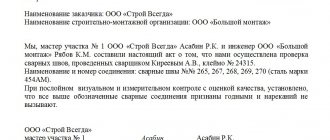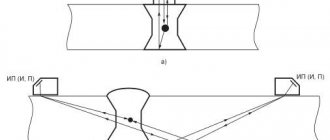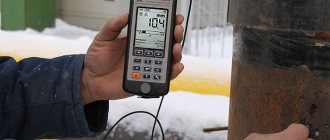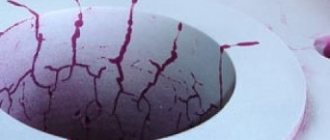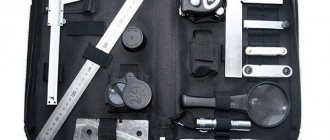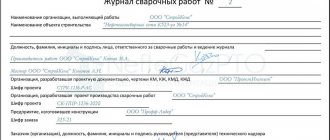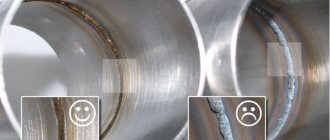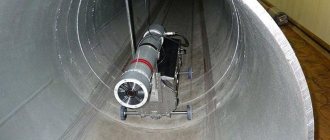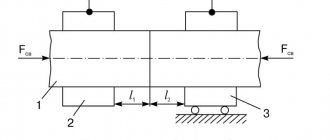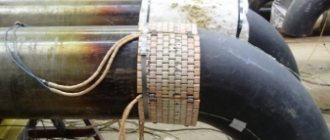Features of the method
Steelscoping allows you to evaluate the chemical composition of the metal of welds. That is, the method allows you to determine whether the connections meet the requirements specified in the regulatory and technical documentation.
Steelscoping is based on visual inspection, i.e. comparing the brightness of existing spectral lines with standard indicators.
This method will allow you to identify the following elements in steels and non-ferrous alloys:
- tungsten;
- chromium;
- nickel;
- titanium;
- phosphorus;
- carbon;
- sulfur.
Areas of use
All products that will operate under high pressure are subject to the procedure for determining the chemical composition of weld steel. These include: cylinders, hydraulic cylinders, thin tubes of distribution systems. Containers intended for the chemical industry and pipelines involved in the communication routes of aggressive substances are subject to mandatory inspection.
The control method is also used after repair work on the installations described above. For example, if flanges or a manifold were replaced in some area, then the welds need to be checked again. When several welders participated in welding work, the seams of each specialist are checked, and not just on one side. The inspected areas are indicated on the drawings so that later they can be easily identified if the work needs to be reworked if a defect is discovered.
Steelscoping
One type of quality control of the chemical composition of pipeline seams and components of various equipment is called steeloscopy. According to the current acceptance rules, seams must necessarily comply with regulatory and technical documentation (NTD). The main task of the specialists who carry it out is visual control, which consists of comparing brightness. They are obtained by analyzing the brightness of spectral lines with reference photographs.
Steelscoping of seams of welded joints
Steelscoping is performed using specialized instruments called steeloscopes. There are 2 types of such equipment:
- Using portable devices, they perform rapid analysis in warehouses and field conditions. In addition, they are used to control large structures. Total weight can vary from 2 to 5 kilograms.
- If steeloscopy needs to be carried out in a laboratory, stationary devices are used. They are much more sensitive than their analogues and can operate for a longer period of time, but the parameters of the nodes studied are extremely limited.
Physical basis of the method
The steeloscopy process is based on the glow of metal vapors in a low-voltage spark. A similar arc discharge is formed using electrodes. The first of them is, in fact, a sample that is to be studied, and the second is a permanent instrument electrode, which has the form of a steel rod or a copper disk. When the arc burns, the substance is transferred from one electrode to another and hot vapors are formed between them. Spectral lines directly depend on the type of metal used. Steeloscopes are equipped with special eyepieces, in which, in fact, you can observe the process of decomposition of radiation into spectral lines. As a result of the data obtained during the research, spectrograms are compiled.
Parameters and design of units
- The selection of the optimal spectral range is of utmost importance (the fact is that the devices of the previous generation have a rather narrow spectrum, which does not allow them to identify all the impurities of the weld);
- the ability to destroy is also of no small importance;
- when choosing a device, pay attention to whether it has an option that will allow you to enlarge the eyepiece;
- The luminous intensity parameter is of no small importance (in essence, it is the difference between the brightness of the vapor glow and the image entering the device);
- Finding the focus of the equipment lens and its eyepiece also affects the veracity of the readings.
Necessary equipment
To carry out diagnostics of welds, special devices are required - steeloscopes. These devices come in two types - large ones in welding laboratories and portable ones in production. Size does not affect the functionality of steeloscopes; all devices have the same set of main components. Large and portable devices function the same.
One of the working elements of a steeloscope is an electrode that lights an arc on the product. It is made from tungsten, steel, molybdenum or copper. For normal operation of the electrode, proper sharpening of the tip is necessary; this is done on a lathe or grinding wheel. Electric current is supplied from a generator located in the equipment housing. The generator supplies current to the rod and initiates an arc.
Legislative framework of the Russian Federation
Free legal aid hotline
- Encyclopedia of mortgages
- Codes
- Laws
- Document forms
- Free consultation
- Legal encyclopedia
- News
- about the project
Free consultation
Navigation
Federal legislation
- Constitution
- Codes
- Laws
Actions
- home
- “RULES FOR DESIGN, MANUFACTURE AND ACCEPTANCE OF WELDED STEEL VESSELS AND APPARATUS. PB 03-384-00" (approved by Resolution of the Gosgortekhnadzor of the Russian Federation dated October 4, 2000 N 57)
5.6. Steelscoping of welded joints
5.6.1. Steelscoping of welds must be carried out to establish the grade compliance of the welding materials used with the requirements of the project and welding instructions or these Rules.
When steeloscoping, you should follow the Instructions for steeloscoping basic and welding materials and finished products.
5.6.2. Welded seams of parts working under pressure from steel grades 12ХМ, 12МХ, 15ХМ, 10Х2М1А-А, 20Х2М, 1Х2М1, 15Х2МFA-А, 10Х2ГНМ, 15Х5М, 15Х5, 08Х13, 08Х17Н13М2Т, 10Х17Н1 should be subjected to steeloscopy. 3M2T, 10Х17Н13М3Т, 08Х17Н15М3Т, 03Х16Н15М3Т, 08Х21Н6М2Т and 06ХН28МДТ, 12Х18Н10Т, 08Х18Н10Т, 08Х22Н6Т and corrosion-resistant surfacing metal in a volume not less than that specified in Table 20.
Scope of steeloscopy inspection
| Vessel groups | Number of controlled welds and corrosion-resistant surfacing metal from the total quantity, % |
| 1,2 | 100 |
| 3.4 | 50 |
| 5 | 25 |
5.6.3. During the steeloscopy process, the presence of chromium and molybdenum in the weld metal should be determined.
5.6.4. Must be controlled:
each weld at one point every 2 m;
places to correct each weld;
surfacing at at least one point.
5.6.5. Steeloscopy inspection may not be performed:
if it is impossible to carry out control due to the inaccessibility of welds (due to the design features of the vessel, according to safety conditions);
due to the small size of the seam (for example, welding seams of heat exchange pipes).
5.6.6. If unsatisfactory results are obtained, steeloscopy of the same welded joint at twice the number of points is allowed.
If the results of re-inspection are unsatisfactory, a spectral or chemical analysis of the welded joint must be carried out, the results of which are considered final.
5.6.7. If a discrepancy is detected in the brand of filler materials used on at least one of the welded joints of vessels of groups 3, 4 and 5a and 5b, steeloscopy of the weld metal must be carried out on all welded joints made by this mechanized welding method.
5.6.8. Defective welds identified during inspection must be removed, the seams re-welded and subjected to steeloscopy.
What is steeloscopy of welds?
Among the non-destructive methods of weld inspection, metal styloscopy is the most “ancient”. It was introduced in the 30s of the last century. It is used to check the homogeneity of connections of high-pressure vessels, boilers, pipelines, and loaded welding metal structures. Steelscoping quickly determines harmful impurities, although the accuracy of the result largely depends on the vigilance of the operator, the method is reliable. The procedure for styloscopy of welded seams is regulated by GOST 7122-81; it is indicated in the regulatory and technical documentation for many types of work: in the production of pipelines, welded process tanks, and support structures.
What is steeloscopy
Firstly, this is an express method of the chemical composition of welded joints, the presence of carbon, sulfur, phosphorus, and other alloying elements in the metal. In the language of textbooks, steeloscopy of seams is a non-destructive testing method based on comparison of the spectral lines of evaporating melt vapors with reference photographs. It is difficult to determine the concentration of components from the spectrum. The operator makes an assessment by eye. The result of steeloscopy is always subjective. But serious accidents can be avoided after testing welds.
Application area
Identification of components that reduce the quality of welds is the main goal of steeloscopy. The metal is capable of becoming saturated with gases during the welding process; the elements burn out at a temperature exceeding the melting point. The analysis reveals violations in the manufacturing technology of welded vessels and pipelines. Under pressure, a defective connection may burst.
Methods of weld quality control
There are various types and means of technical control, they all have their own advantages and disadvantages, features and nuances. But despite the differences, they are all designed to test the seams for strength and durability. The quality of welded joints largely depends on the welder and the components used, so the outcome of the inspection can be predicted. But we still recommend quality control to be sure that the products will last a long time.
The quality of welded joints can be determined by visual inspection (perhaps the most common method), ultrasonic, magnetic, capillary and radiation (radiographic) testing; welds are also monitored for permeability. There are other methods for monitoring welds, but in this article we will list the most common and easy to use. We recommend performing operational quality control, i.e. first inspect the seam, then carry out penetrant testing and so on. However, first things first.
Visual control
Let's start with visual control. This is the easiest and fastest way to find out the quality of welds. You don't need special equipment or liquids, your attentiveness is enough. Carefully inspect the welded joint: there should be no visible defects such as cracks or chips, the seam should have the same width and height in all areas. External inspection of welding seams also allows you to check the presence or absence of lack of penetration, sagging, and uneven seam folds. All these are defects, the detection of which can safely indicate low quality of the connection. For more effective quality control of welds, we recommend using a powerful lamp and a magnifying glass; a tape measure or ruler, or a caliper would also be useful. With the help of such simple devices, you can measure the size of defects and understand what to do with them in the future.
Of course, using this method you will not be able to perform full inspection of welded joints of pipelines, welded joints of gas pipelines or other critical structures, but visual inspection will be the first operation, after which you can apply other inspection methods.
Penetrant control
Methods for quality control of welded joints also include weld testing. For this, the capillary method is used. Its essence is extremely simple: for control, special liquids are used that are able to penetrate the smallest pores and cracks, called capillaries.
Using capillary operational control, you can check the quality of any metal, with any composition and shape. Often this method is used when you need to find out the presence of hidden defects that are invisible to the eye, but there is no budget, since capillary testing is very easy to use and does not require expensive equipment.
Capillary assessment of the quality of welded joints is carried out using liquids called penetrants (from the English word “penetrant”, which means “penetrating liquid”). Such liquids have low surface tension, which is why they easily penetrate small capillaries and remain visible to the eye. Essentially, penetrants fill cavities and color defects, thereby making them visible.
Now you can find many recipes for preparing penetrant, each of which will have its own properties and characteristics. You can prepare a penetrant based on water or any other organic liquid (turpentine, benzene, this also includes the quite popular test of welds with kerosene. Such penetrants are very effective and sensitive to the slightest defects. They confidently occupy one of the leading positions among quality control methods.
Checking the tightness of welded seams
Weld testing does not end with liquids. They also need to be checked for leaks. The leak testing method has many names: leak testing, bubble testing, pneumatic testing, hydro testing and many others. But regardless of the name, their essence remains the same: detection of through defects that impair the sealing performance of the welded joint. Checking welds for leaks is performed using gases (oxygen or nitrogen) and various liquids (for example, water). The method is in many ways similar to the capillary method, but here the gas or liquid is additionally supplied under high pressure, under which they are distributed into the defective cavities and come out. This method has its own classification. There are pneumatic and hydraulic controls, and seams can also be checked using vacuum or air blowing; these are subcategories of pneumatic control. But let's talk about everything in more detail.
Let's start with the pneumatic method of quality control of seams. It involves the use of gas or air, which is directed to the connection under pressure. In this case, the seam is lubricated with a soap solution. There is also a type of pneumatic control called vacuum control, when an artificial vacuum is created using special equipment, a part is placed in it, and the seam is also pre-wetted with a soap solution. In areas with through cracks, bubbles will form, indicating the location of the defect.
When preparing a soap solution, use one bar of soap per liter of water. If you have to work at low temperatures (outside in winter), then it is recommended to replace more than half of the water with alcohol. We also recommend connecting a pressure gauge, with which you can monitor the pressure indicator and be able to notice how it will drop when defects are detected. It would also be a good idea to use a safety valve to maintain safety precautions.
The simplest form of pneumatic testing is to immerse the part in water, without lubricating the seams with soapy water or using pressure. If the seam has defects, they will make themselves known when small air bubbles begin to appear from the welded joint. This method of quality control can be called field, but it is quite effective.
There is also another type of pneumatic inspection called quality control of welds and joints using ammonia. Ammonia is supplied instead of gas or air, and the seams are pre-covered with special paper tape. Ammonia passes through the seam and if there are defects, red spots appear on the tape.
The second type of leak control is hydraulic. Here pressure is created using water or oil. This is a very interesting method, since the part is kept in liquid for 5 to 15 minutes (depending on the characteristics of the metal), while the area near the seam is tapped with a hammer, the blows should be weak. If there are defects, then upon impact, liquid will begin to flow out from the intended place with a crack or other damage.
Magnetic control
The magnetic control method uses the basics of electromagnetism. The inspector or welder, using a special device, creates a magnetic field around the seam, which emits a stream of so-called electromagnetic lines. If they are distorted, then there are defects. Distortions are recorded using magnetic particle method.
With magnetic particle welding, ferrimagnetic powder is first applied to the surface of the weld, which, when the electromagnetic line is distorted, begins to accumulate at the defect site. Because of this, magnetic inspection is only available when working with ferrimagnetic metals. Aluminum, copper, steel with a high content of chromium and nickel cannot be inspected. In general, this is a very effective, but inconvenient and expensive method, so it is used only when monitoring particularly important components.
Ultrasonic testing
The ultrasound method is very interesting. It is based on the properties of ultrasound. Ultrasonic waves are easily reflected from the edges of a crack or chip, since they have different acoustic properties. In simple words, we apply ultrasound to the seam, and if it encounters a defect along its path, it is distorted and displayed in a different direction. In this case, different types of defects distort the ultrasonic wave in different ways, so that they can be easily identified.
Weld quality control using ultrasonic devices is used everywhere, since it is a fairly effective and at the same time inexpensive method. Compared to other methods (for example, magnetic or radiation), there is no need to take into account any characteristics of the metal or purchase expensive equipment. But there are also disadvantages: ultrasonic inspection of the welded joint must be carried out by a specialist, and not by an ordinary welder.
Radiation control
Radiation weld inspection (also called “radiographic inspection” and “gammagraphic weld inspection”) is a mini version of conventional x-rays. Gamma rays penetrate the metal and all possible hidden defects are recorded on a special film. This is the most advanced and expensive method of quality control; it requires modern equipment and qualifications from the inspector or welder. Also, excessive work with such a device can have a negative impact on human health.
Recently, digital radiography has appeared, which is performed using a computer. Here, instead of film, special reusable plates are used, which are compatible with any radiation sources. But unlike classical radiation monitoring, with the digital method, images are saved directly to a computer, they can be scaled and cropped. In the future, the developers plan to make this process automatic so that human presence is not required.
Steelscoping: non-destructive testing
4.84 (Votes: 25)
The general procedure for performing the non-destructive testing procedure is established by the provisions of Rostechnadzor Order No. 490 dated November 21, 2021. This regulatory document defines the general conditions for the use of methods that are safe for analysis, and also determines the rules for the implementation of relevant work. The list of basic non-destructive testing methods and typical technologies for their use are described in the interstate standard GOST 18353-79. This standard contains about ten different positions. It also states that this list may be supplemented by other methods for verifying the integrity of objects.
Definition
Steelscoping is a method that helps to quickly determine the chemical composition of the weld metal for compliance with the standards of regulatory and technical documentation. This will help determine the presence of carbon, sulfur, phosphorus, chromium, nickel, etc.
The general procedure for performing the non-destructive testing procedure is established by the provisions of Rostechnadzor Order No. 490 dated November 21, 2021. This regulatory document defines the general conditions for the use of methods that are safe for analysis, and also determines the rules for the implementation of relevant work. The list of basic non-destructive testing methods and typical technologies for their use are described in the interstate standard GOST 18353-79. This standard contains about ten different positions. It also states that this list may be supplemented by other methods for verifying the integrity of objects. In this case, the rules and conditions for their application must be established by federal norms and regulations approved by order of Rostechnadzor.
Special guidance documents
- Definition (Added 04/18/2019)
- Special guidance documents
- Non-destructive testing by steeloscopy: application of the method
The technology for testing the integrity of an object using non-destructive testing methods can vary significantly depending on the following factors:
- the material from which the object is made;
- size of the analyzed object;
- the presence of welded joints, moving parts and other features;
- scope of application of the equipment or part;
- other factors.
Depending on the above reasons, the inspection of an object can be carried out using one or another non-destructive testing technology. For the purpose of unifying the procedure within various fields of activity, special guidance documents are being developed.
Non-destructive testing by steeloscopy: application of the method
Thus, steeloscopy is regulated by the provisions of RD 26.260.15-2001. According to this regulatory document, steeloscopy is a non-destructive testing method that is used to control the quality of the following elements:
- system elements and vessels made of high-alloy types of steel. The requirement for the mandatory nature of steeloscopy applies to those that are under pressure;
- welds connecting these elements. Steelscoping is carried out in places and volumes established by the manufacturer.
To use this method, special measuring instruments are required - styloscopes. Steelscoping is a non-destructive testing method that involves a qualitative spectral analysis of the relevant objects. During its execution, the metal is checked for compliance with current requirements.
Capillary control using kerosene
In earlier times, kerosene was used to find defects. This liquid was widely used in everyday life and technology. Kerosene almost does not evaporate under normal conditions, but has good penetrating ability due to its low viscosity and high polarity.
Because Kerosene is colorless, then welders used chalk and other substances to correctly assess the presence and size of shells, cracks and cavities.
The kerosene method, due to its simplicity, is still used in practice today. Most often, this method is used to search for through defects in pressure tanks; it is also used when testing fuel compartments or products with various welded joints.
Inspection procedure and sensitivity for the kerosene control method:
Advantages and disadvantages of the method
Steeloscoping has a number of “advantages”, thanks to which this equipment continues to be used in relevant work. Among the positive aspects of the control method are the following:
- after inspection, the integrity of the product is maintained;
- the dimensions of the equipment allow it to be placed near the workplace;
- the device, with suitable ventilation, is safe for health;
- helps determine the presence and quantity of most known impurities.
But there are also disadvantages to this technique. Learning to distinguish substances by the brightness of the glow and the width of the lines takes time. Operator training can take up to six months. Having completed the training, the assessment of the result will still depend on the subjective opinion of the specialist and his experience. Two operators may draw different conclusions. Although the technique allows you to identify the presence or absence of alloying elements, it is impossible to determine the content of sulfur and carbon, which, in certain quantities, can have a negative effect on the weld. The weak glow from the electric arc overloads the retina and spoils vision. Without exhaust hood, the operator inhales harmful gases into the lungs.
Ultrasonic
An ultrasonic wave has penetrating power and can be reflected from the interface between media in which sound propagates differently. This property is the basis of this method. The device consists of a source and receiver of an ultrasonic wave. If there are no defects inside the metal, then the speed of sound passing through the part in the forward and reverse directions is calculated. If there are cracks or pores, the wave reflected from the bottom face will come with distortion. There is a special classification of the resulting paintings that allows one to distinguish between different types of defects.
Ultrasonic flaw detection is superior to magnetic and radiation in its popularity and applicability. The disadvantage is the complex signal decoding system. To conduct the research, a special qualification of the master is required. The limitation on the use of the described method is associated with the coarse-grained structure of metals. Austenitic steels and cast iron are not subject to examination.
Paperwork
A special magazine is provided for welding. It is the primary document drawn up in accordance with the requirements of SNiP. The design organization draws up a list of components in the metal structure that must be handed over to the customer with the preparation of welding documents.
In addition to the magazine, welding work is accompanied by a diagram of the joints, certificates for consumables (electrodes, flux or filler wire) and quality control reports on the outside of the product are attached.
If ultrasound or other specific studies were carried out, the results and conclusions on them are also attached.
All this allows us to talk about the quality of welding and reliability of the design. Only after the welding documentation has been submitted in full are further procedures for accepting the metal structures of the facility carried out.
